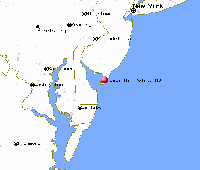 |
 |
 |
 |
 |
 |
 |
 |
 |
 |
 |
 |
 |
 |
Monarch Migration Update: September 29, 1998
Today's Report Includes:
 |
"The monarch landed on a large orange bush outside of an eating establishment. It was a Mexican Restaurant,"
reported Ms. Chamblee of G.P. Babb Middle School
(cchamblee@mindspring.com)
Here is the flurry of reports we received from the southeast and other regions:
09/24/98 Busick, NC (36.05N, -82.19 W)
"I witnessed a significant migration of monarchs across the Blue Ridge in Western North Carolina on 9/24.
In three 5-minute counts taken between noon and 2 p.m., I recorded 87, 67 and 55 monarchs passing a given point.
A conservative estimate, I think, would be that I saw about 3,600 monarchs passing through that gap during the
6 hours I was there. The monarchs were riding the air currents, flapping occasionally, but having an easy time
of it."
Elizabeth Hunter (peterm@mitchell.main.nc.us)
09/26/98 Rocky Mount, NC (35.95 N, -77.69 W)
"We spotted two to three monarchs per mile for a stretch of about five miles." (mmpteach4@hotmail.com)
09/26/98 Bedford, VA (37.32 N, -79.52W)
"Saw approximately thirty monarchs fly by, one every 30 seconds, and they seemed to be following the same
line of flight heading S/SW." (donovan.bort@ericsson.se)
09/25/98 Rocky Mount, NC (35.95 N, -77.69 W)
Fourth grade students at Benvenue Elementary reported seeing four monarchs on the school playground. Another single
monarch was sighted on Highway 4 between Rocky Mount and Raleigh. (mmpteach4@hotmail.com)
09/25/98 Unicoi, TN (36.18 N, -82.30 W)
At 2:00 pm 6-8 butterflies began to soar across the playground about 8-10 minutes apart - flying high. Their wings
were not tattered looking. Flying toward Asheville, North Carolina. (cmatric@hotmail.com)
09/24/98 Smithfield, NC (35.48 N, -78.34 W)
Today finally I spotted a beautiful female monarch around our white butterfly bush in the courtyard of our school.
I have not be able to detect any eggs on our milkweed yet but maybe soon now that the monarchs are coming through.
Monarch sightings were very scarce this summer."
(t40437@johnston.k12.nc.us)
09/24/98 Sterling, VA (38.98 N, -77.45W)
In P.E. class we spotted an orange dot in the grass. When we gathered to look it was a Monarch !!! In fact, we
saw three together. They flew around and up into the sky over the school. The weather was cool, sunny and a slight
wind was blowing from the north. (jlenz@pen.k12.va.us)
09/24/98 Sterling, VA (38.98 N, -77.45W)
At 10:00AM we went out for recess and spotted 5 monarch butterflies on the field behind our school. The students
were able to get close enough to the butterflies to see the patterns on the wings. This is our first sighting.
We are excited! (jayers@pen.k12.va.us)
09/23/98 Clarkesville, GA (34.68 N, -83.52W)
I sighted the first migrating Monarch of the year at our school, North Habersham Middle School. It was sunny,
85 degrees,with a wind of 15 mph and the butterfly was on flying near grass in a mowed area. When I saw that Texas
had reported findings, I was worried that the Monarchs were missing us . My students will begin their watches,
recording data for the project. (bhunt@habersham.k12.ga.us)
 |
09/28/98 Seabrook, TX (29.75 N, -95.36 W)
Last week I reported one bedraggled monarch, its left wing about half gone. That little fellow stayed around all
week, impossible to mistake for another with the major injury. It's kind of nice to be able to follow one butterfly
by his build!
Don Perkins (dperkins@rice.edu)
Northern Regions Watch for Last Monarchs of the Season
09/27/98 Livingston, WI (42.90 N, -90.45 W)
"We only see a few singles now. We think the end is near. We're looking for the one with 'the end'
on its tail. Cory, a sixth grader, did report a large group of monarchs in his pasture Sunday. The heifers were
going crazy chasing them he said." (igemscmp@mhtc.net)
 |
Challenge Question #4
"Do you think the data collected so far at Cape May show there a fewer monarchs this fall than usual? Why or why not?" Include specific examples from the data to support your answer.
|
End of |
1992 |
1993 |
1994 |
1995 |
1996 |
1997 |
1998 |
|
1 |
7.52 |
11.95 |
95.96 |
43.3 |
9.08 |
184.49 |
3.02 |
|
2 |
10.94 |
12.25 |
155.29 |
35.11 |
6.66 |
125.12 |
28.76 |
|
3 |
12.13 |
41.65 |
143.49 |
28.86 |
52.29 |
155.55 |
20.56 |
|
4 |
12.95 |
67.83 |
123.57 |
27.22 |
58.99 |
173.27 |
38.95 |
|
5 |
11.89 |
82.03 |
128.63 |
26.95 |
73.17 |
152.96 |
|
|
6 |
12.26 |
80.6 |
108.87 |
26.87 |
69.1 |
140.47 |
|
|
7 |
12.66 |
71.77 |
95.34 |
28.78 |
66.42 |
129.1 |
|
|
8 |
11.17 |
65.49 |
91.44 |
27.41 |
63.04 |
114 |
|
|
Year Average |
10.41 |
62.88 |
84.95 |
25.89 |
58.91 |
106.61 |
|
 |
Madoc Cub Scout Pack , Trenton, ON
Barbara Williams, Riverdale, MD
Dean S. Luce School, Canton, MA
Washington School, Richland Center, WI
Hillsboro-Deering, Hillsboro, NC
Grove Elementary, Montrose, Illinois
St. Peters School, Trenton, ON
Let us know when your monarchs are on their way!
The Next Monarch Migration Update Will be Posted on October 6, 1998.
Copyright 1998 Journey North. All Rights Reserved.
Please send all questions, comments, and suggestions to our feedback form
 |
 |
 |
 |
 |
